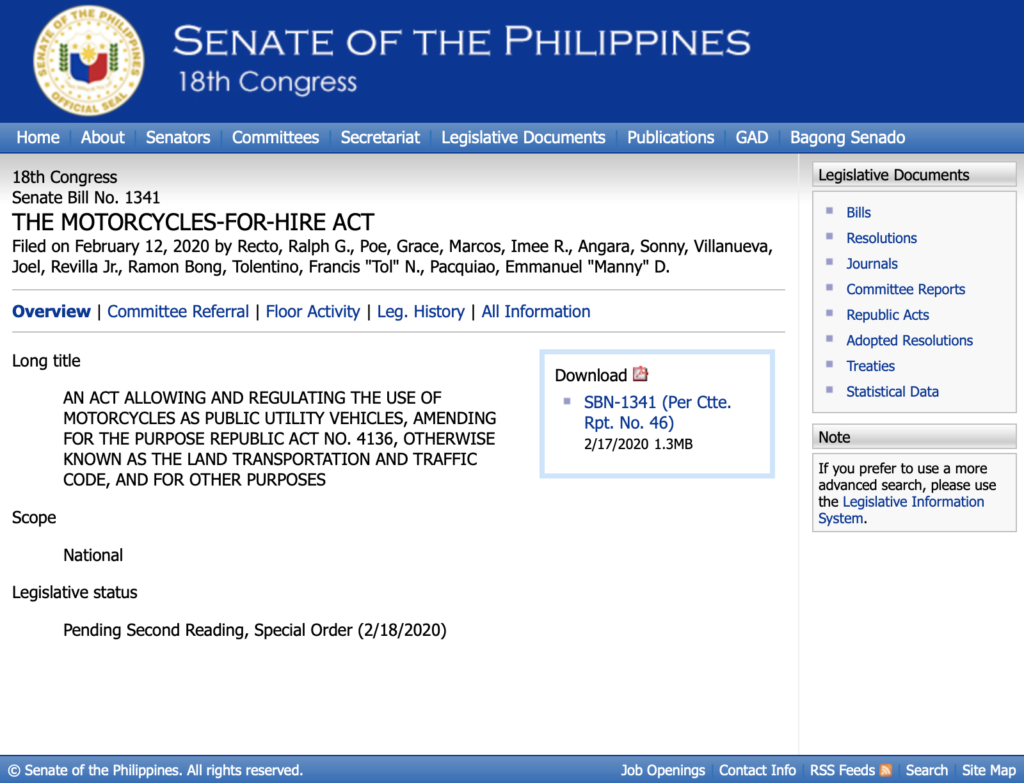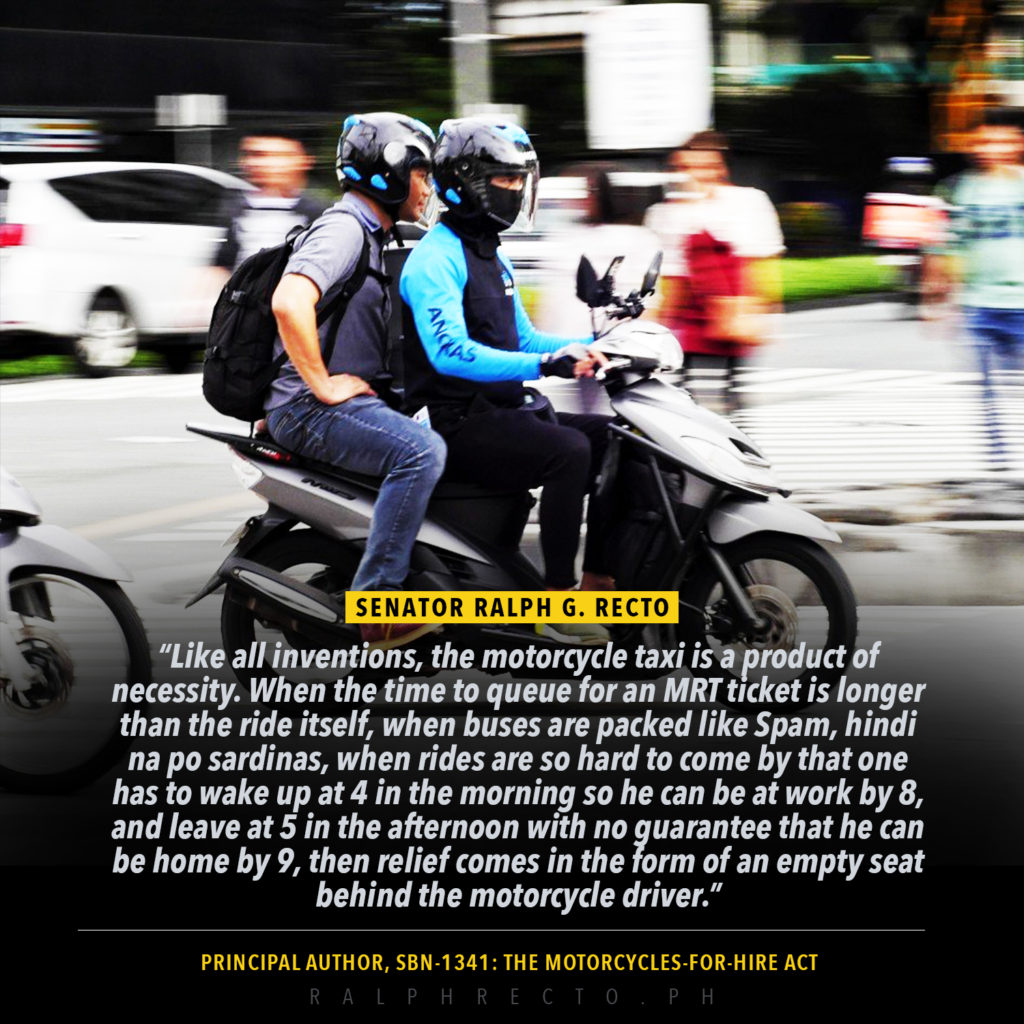Sponsorship Speech on SB 1341: Motorcycles as Public Utility Vehicles
Mr. President:
Throughout history, legislation has always marched behind technology. It has always been innovation first, regulation later.
And most often, government’s intervention follows this Reagan doctrine: If it moves, tax it. If it keeps moving, regulate it. And if it stops moving, subsidize it.
And when confronted with something new or unfamiliar, toy with the idea of prohibiting it.
In the case of airplanes, it did not have a smooth takeoff as a sanctioned passenger carrier.
Like biplanes flying through the clouds then, it met turbulence along the way to being permitted by the government to fly paying human cargo.
But you know what: From trains, to planes, to automobiles, it was government regulation which made them safe through the years.
And such, and I say this with certainty, will be the case of motorcycle taxis.
This bill, condensed from five measures, bravely confronts a phenomenon that is here and now.
This is not about merely ratifying what is already existing. The act of Congress to permit and regulate what is now in operation is not a fait accompli.
On the contrary, this bill and the implementing rules it would birth, would improve the status quo, resulting in a public transport that is safe for the driver, the passenger and other users of the road.

Mr. President:
Ours is a motorcycle republic. 7 in 10 motor vehicles today run on two wheels.
At almost 19 million, there is one motorbike per family. There are more “motors” than carabaos today. The likes of Hondas have long outnumbered our horses.
And half of these motorsiklos are used for livelihood— to deliver food for the perpetually hungry millennial, deliver packages, and as tricycles that bring people to work, or produce to market.
In upland villages in Mindanao, people even ride ten-dem—ten-demdahil sampu sila—in circus-like fashion, in bikes with wings, or outriggers, that they look like land bancas.
These are the mountain-summiting habal-habals and Skylabs in Mindanao. They’ve been there for four decades in their stratospheric routes.
And there’s this relatively new urban phenomenon, the motorcycle taxi, that zips one paying passenger through our cities’ gridlocked roads.
Like all inventions, the motorcycle taxi is a product of necessity.
When the time to queue for an MRT ticket is longer than the ride itself, when buses are packed like Spam, hindi na po sardinas, when rides are hard to come by, that one has to wake up by 4 in the morning, so he can be at work by 8, and leave by 5 in the afternoon, with no guarantee that he can be home by 9, then relief comes in the form of an empty seat behind the motorcycle driver.

There were many independent contractors before some entrepreneurs married ICT with the bike, to create a riding-hailing app, driven by well-trained, carefully curated drivers.
In practice, courtesy of the pilot period government gave them, they proved that with right driver training, a motorcycle can indeed be a safe ride.
There remains one roadblock though for them to operate legitimately – and that is the more-than-half-a-century-old law which bans a motorized two-wheeler as a for-hire vehicle.
If this provision in RA 4136 will not be deleted, then millions of de factomotorcycle riders cannot be flagged off as legal paying passenger vehicles.
But delisting them, Mr. President, is just part of what is needed to de-colorumize this big subset of the land transport sector.
Congress, as the rule-setting body, must also lay down the minimum specifications of a motorcycle taxi, one with safety as the main benchmark.
And this bill sets it—from engine size, to minimum speed, to build, to weight.
This is the basic set of rules and requirements which the Land Transportation Franchising and Regulatory Board should build on, which will cover not only the vehicle specs but the skill and training a driver must demonstrate before he or she can be licensed.
This bill, however, is not a mother-of-all franchises that will mass legalize motorcycle taxis in one stroke of the pen.
Drivers will still have to secure a Certificate of Public Convenience or a special permit from the LTFRB.
This bill is also in response to the call of the DOTR that for as long as the ban in RA 4136 exists, their hands are tied in legalizing the likes of Angkas, Joy Ride and others.
True, for the river cannot rise above the spring.
Mr. President:
The bike was and is apparently the ride of choice of the President. He is our biker-in-chief.

And by safely logging tens of thousands of kilometers in criss-crossing Mindanao and the Visayas, he had demonstrably shown the motorbike as a safe ride.
Although hundreds of CCs separate the bikes they ride, in general, what is good for the president must be good for the ordinary citizen.
So let us pass this bill, my dear colleagues, not for the sake of the president, but for the people.And finally, for the record, Mr. President, I continue to ride bikes. It was what I used in courting the lady who would later become my wife.
RELATED ARTICLES:

